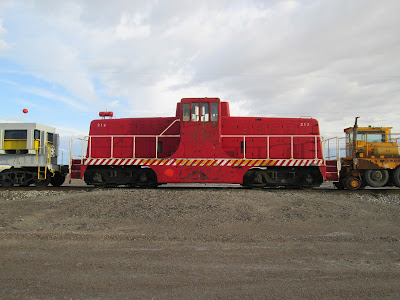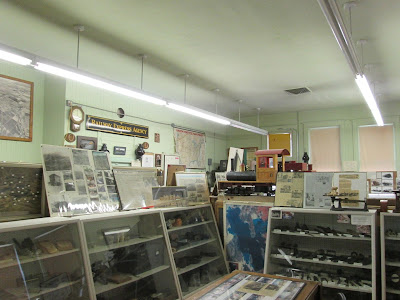DEP founder Josh Bernard and Jacob Morgan at work needle gun scaling old paint off the surface of Columbia Steel 300 at the Heber Valley Railroad.
For me the past few months of model railroading have been rather slow for me. Having recently finished the school semester; I am now back to working full time most weeks, keeping me behind a desk rather than out trackside admiring the trains. After the euphoric rush of excitement of chasing 844 through southern Idaho a few months back, it seems things are moving along slowly waiting for that next big railfan adventure. But to claim that nothing is happening in the railfan hobby the past few months would be remiss, and in this relatively short time I have had several memorable experiences! This is just a few of the interesting things that have kept myself and the other DEP editors busy the past few months as we ease into the summer season!
The LUE 46 at work at Central Garfield on May 15, 2017
The First Full Gathering of the DEP Editors
May 15, 2017 was the first time Josh Bernard, Schon Norris, Matt Liverani, and I were all able to get together to railfan. We had lunch at the Red Iguana 2 in Salt Lake City; and spent the remainder of the day watching freight traffic through Salt Lake City's Control Point 784 and North Yard. We had a blast and got to witness a lot of busy mainline action through the city that day!
A westbound Union Pacific manifest pulls along North Yard on Main 1 with another cut of freight cars next to it in the yard tracks.
UP 1208 a unique former Kennecott Copper Company high cab mine GP engine leads a returning freight through CP 784 into North Yard.
A southbound Frontrunner slows down to approach the North Temple Bridge Station.
Josh admires the UP track inspection car resting for a moment before continuing east into the Grant Tower wye track.
On May 18, only a few days after our DEP meet; my Dad invited me to join him on a trip out to Wendover he had to do for work. It was the first time I had been to Wendover in years and I was interested to see what I could find there in this desolate desert border community. Wendover was founded by the Western Pacific and hosted a crew change point and a small roundhouse during the steam era. A local branchline operation the Deep Creek Railroad interchanged with the WP in Wendover until that line was abandoned during the Great Depression. WWII brought the US Army Air Force to Wendover with the new base in the town. The base gained notoriety with its use for training by the 509th Composite Group the first nuclear bomber group in world history which would be later lead the attacks on Hiroshima and Nagasaki, Japan.
Most Utah residents know the area now for its neighbor city West Wendover, Nevada and its casinos and concert halls. However rail activity remains an ever present part of the Wendover community, and it is one of the few places in Utah to embrace its connection to the Western Pacific Railroad. A potash operation and the Robinson Mine's copper ore loader keep the rails busy even though there is no longer an official crew change point in the city.
This unique ex-Canadian National GMD-1 now works for the Robinson Mine's switching cuts of copper ore cars. Spiritually this operation is the successor to the famed Nevada Northern Railway, as the copper ore from the Robinson operation originates at the Ruth pit which was once served by the Nevada Northern.
A scale test car at the copper loader operation. The frame suggests the car was built using recycled parts from retired freight cars; perhaps an old slag pot from a smelter or mill?
Broken Arrow's GE center cab at the Robinson Mine operations with a trackmobile and the scale test car.
Forgive this non-railroad related photo, but it seems inappropriate to mention Wendover without discussion about the area's history with the Air Force. This F86-D "Sabre Dog" is kept at the Wendover Airport. A massive restoration project on the same field is restoring the "Enola Gay Hangar" a large structure built for B-29 bombers used by the 509th Composite Group during its training regiment in Wendover.
A westbound coal train (possibly heading to the North Valmy Power Plant in Nevada, although an export train heading to a west coast port is probably more likely), rolls through Wendover on its trek west. These coal trains always seem to be a place for grungy battle worn GE units to battle out on. After a long stretch of flat lands across the Salt Flats to reach Wendover, this coal train will soon be at the remote Arnold Loop in Nevada, climbing over the mountains separating the desert valleys.
Two Union Pacific Automated Way boxcars in Wendover. One preserved and painted in Western Pacific tribute colors which is slowly fading off and revealing the UP yellow beneath. The other in a siding near the mainline, still in service to Union Pacific!
A westbound coal train (possibly heading to the North Valmy Power Plant in Nevada, although an export train heading to a west coast port is probably more likely), rolls through Wendover on its trek west. These coal trains always seem to be a place for grungy battle worn GE units to battle out on. After a long stretch of flat lands across the Salt Flats to reach Wendover, this coal train will soon be at the remote Arnold Loop in Nevada, climbing over the mountains separating the desert valleys.
Two Union Pacific Automated Way boxcars in Wendover. One preserved and painted in Western Pacific tribute colors which is slowly fading off and revealing the UP yellow beneath. The other in a siding near the mainline, still in service to Union Pacific!
Tequilla, Shi-Tzus, and TRAX: Random Day by Day Raifan Adventures
On May 20, the private car "The Patron Tequila Express" had a layover in Salt Lake City having arrived on the California Zephyr. This gorgeous vintage passenger car looked wonderful even when admiring it from afar.
A westbound BNSF Provo-Stockton trackage rights train at Stauffer on the former Western Pacific mainline in the late evening.
A westbound BNSF Provo-Stockton trackage rights train at Stauffer on the former Western Pacific mainline in the late evening.
I decided to take my family dog Lucy out on a walk near Erda, Utah on May 27 which was a bright sunny morning. A passing SLC to Long Beach intermodal startled Lucy and she didn't seem to be happy to be there at all when a quartet of SD70M engines roared past.
Despite her initial apprehension, it seemed Lucy was watching the train roll by after a minute or two of being near it!
The Siemens SD-100/SD-160 models were once a common sight on the University extension on the TRAX system, but the Redline completion to Daybreak has meant they have been mostly replaced by the newer S70. Due to TRAX M.O.W. work and the resulting system delays, for a few weekends this year UTA has been running a special "Black Line" from Salt Lake Central to the University Hospital which uses the classic SD models once again. The photo was taken at the hill connecting 400S and 500S, one of the steepest grades (if not the steepest) on the UTA rail system.
Museum Season and Restoration Work!
Summer is usually a busy season for both tourist railroads and railroad museums. Of note, many of the small town museums such as the Tooele Valley Railroad Museum operate on a scheduled summer season. I dropped by the Tooele Museum on its first day open on the Tuesday following memorial day.
Summer is usually a busy season for both tourist railroads and railroad museums. Of note, many of the small town museums such as the Tooele Valley Railroad Museum operate on a scheduled summer season. I dropped by the Tooele Museum on its first day open on the Tuesday following memorial day.
Among the small town local museums now open for summer is the Tooele Valley Railroad Museum. This photo was taken inside the former Tooele Station at the museum shortly after their opening day for the season. The museum's operating season lasts until Labor Day when the museum.
One of the most interesting things happening this summer is a volunteer effort organized at the Heber Valley Railroad to cosmetically restore Columbia Steel #300, an 0-6-0 steam engine. The effort was organized by Parker Wilson, a longtime volunteer at Heber. Cosmetic restoration had began on the engine in 2013 by a local youth group, but they abandoned the project shortly after starting it. The abandoned effort had done enough work to allow the Heber shop crew to paint the tender of the locomotive, but the rest of the engine was left bare. The following years #300 sat mostly neglected on the Heber property, as the available workers were focused on their other engines.
Parker began bouncing around the idea of getting a group of volunteers together to provide the man power needed to get #300 cosmetically restored. In an ultimate example of "if you want something done do it yourself" mentality he reached out over social media to find other people to join him working on the engine. Both Josh and I decided to join his efforts on the first day of work on June 3, 2017. We were joined by two other railfans Jacob Morgan and Mason McAllister. Both Josh and Jacob M. have experience working on DRGW 223 up in Ogden while Parker and Mason have done work at Heber before.
The five of us set off to paint stripping the running gear on the right side of the engine on our first day of work at the site. The Heber Valley Railroad had switched the #300 to the backside of their shop, where we could plug into their compressed air system and work in the shade the building offered. We got to tour around the shop a bit seeing the Heber's newest acquisition a heavyweight streamliner passenger car getting work done on it. We also got to take a look at Union Pacific 1011, a 1940 vintage NW2 switcher which should be returning to service at Heber in the coming months.
Parker stripping paint off the running gear on Columbia Steel #300.
My face covered in paint chips stripped off the #300 during our work on it. It was pretty messy!
Another view of Parker paint stripping #300 during our first work session. Once paint is removed the metal surface is polished with a wire brush, and then it is ready for a new coat of paint.
In our few hours of work on the #300 we made swift progress, and Parker by the end of it had began testing the rotary wire brush on a few segments to see how easy they polished up. Decades of rust and grime came off under the force of the brush, and underneath the metal shined like new. We hope that paint will be able to start going on soon as teams strip off the old paint and the surfaces are polished. Parker even mentioned that part of the cab on the right side which was rotted out may be replaced by a newly fabricated piece of sheet metal by the shop crew. Hopefully before this summer season is finished Columbia Steel #300 will have returned to its former cosmetic glory!
-Jacob Lyman






















